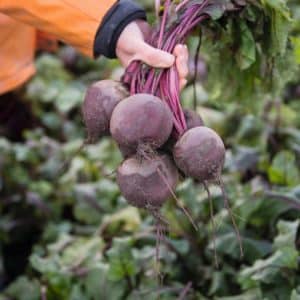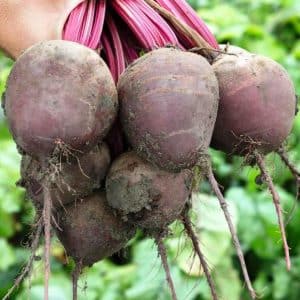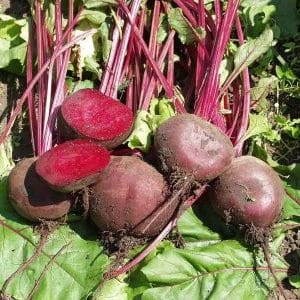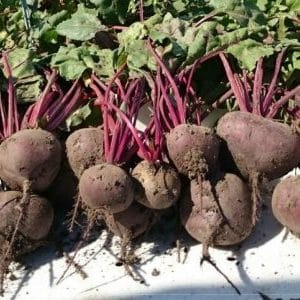Why do gardeners prefer the beet hybrid “Vodan f1” and how to grow it correctly
Vodan f1 beets have a number of interesting features and are widely used in cooking and medicine. With proper agricultural technology, the hybrid produces a rich harvest.
We will tell you in this article what beneficial properties the root vegetable is endowed with, how to plant it and care for it.
Description
To make it easier to understand the advantages and disadvantages of a crop, let’s consider the key points of its origin, features and productivity characteristics.
Origin and development
At the end of the 20th century in Holland they tried to develop a new variety of beets. For the appearance of the desired properties in plants, specific conditions were created: soil contamination, changes in sowing dates, temperature variations, different feeding areas, changes in day length.
As a result of repeated attempts, breeders have developed a new hybrid, which is characterized by high germination, resistance to drought, excellent taste, and invulnerability to diseases and pests.
Distinctive features
As a result of recombination of the properties of previous plants, the new generation hybrid acquired a number of Features that make it stand out:
- sweet rich taste;
- germination probability - 94%;
- early ripening of root crops (85–90 days after emergence);
- high productivity;
- resistance to diseases and pests;
- large vegetables;
- absence of bolting;
- multi-sprouting, which does not affect the yield and quality of the fruit - it is only important to pinch off weak sprouts;
- lack of color, which does not reduce the quality of root crops;
- resistance to cold and drought;
- long-term storage even with early sowing.
Fruit characteristics, yield
Wodan f1 is an early ripening crop. Harvesting occurs approximately 90 days after germination. The root vegetables are round in shape, the flesh is a rich dark burgundy color, contains a large amount of water, and emits a subtle beetroot aroma. The skin is thin, smooth. The leaves are brightly colored, the rosette is strong and well developed, tops low, leaves straight, directed upwards.
The average weight of vegetables is 200–500 g, the fruits of the same crop are almost identical in size.
The yield of the hybrid is high: 20–25 tons per 1 hectare of sowing (without watering). With regular fertilizing and soil moisture, productivity almost doubles: about 50 tons per 1 hectare.
How to grow
To avoid possible difficulties when cultivating a crop or to minimize them, it is important to understand in the intricacies of growing Vodana.
Planting by seeds
Before sowing, hybrid seeds are not soaked, since the manufacturer has already treated them with fungicides that prevent the development of diseases in plants and their susceptibility to insect pests.
To obtain a rich and high-quality harvest, adhere to some rules when working with seeds:
- Sowing in open ground is carried out when the temperature reaches +12…+15 °C.
- The area is dug up and leveled with a rake so that large clods do not remain.
- Create grooves 2-3 cm deep. The distance between the rows is about 50 cm. This will provide the sprouts with access to the sun, without which their growth will slow down.
- Every 10 cm, seeds are placed in the holes made, watered with warm, settled water, sprinkled with soil and moistened again.
- In the first 2-4 weeks, the beds are covered with a film that will retain moisture and protect from unfavorable climatic factors.
Seedling method
To harvest an early harvest of root crops, beets are grown using seedlings:
- Soil for vegetables is poured into small cups or cassettes (the diameter of the containers is at least 10 cm).
- To disinfect, water the soil with boiling water or a strong solution of potassium permanganate, and after cooling, make holes 2-3 cm deep.
- Seeds are planted in the grooves made.
- The containers are placed in the sunniest place in the house.
- At about 7–10 days (at room temperature), the first shoots appear.
- Excess sprouts are removed from plants, leaving the strongest and strongest ones.
- Water the seedlings as the soil dries out.
Diving into the beds, the sprouts are planted together with earthen clods so as not to damage the root system. The seedlings are well watered and sprinkled with earth.
Reference! In order for the seedlings to better adapt to new conditions, they are covered with agrospan. The material protects plants from the scorching sun and strong wind, and the necessary moisture is retained underneath.
Care
The main stage of cultivation is plant care:
- the beds are watered 1-2 times a week;

- after each irrigation, the row spacing is slightly loosened;
- weeds are removed immediately to avoid pest attacks;
- to slow down the growth of weeds and preserve moisture in the soil, the beds are mulched with fresh and dry grass, which alternate as they are laid;
- Fertilize the crop with saline solution (take 1 tbsp of coarse table salt per bucket of water). Water the beds with the product every 2 weeks;
- For growth, root crops require fertilizing with nitrogen (200 kg/ha), phosphorus (75 kg/ha), potassium (250/ha), and kieserite (100 kg/ha).
Features of cultivation and possible difficulties
Despite how easy it is to care for a hybrid, there are several factors that hinder the active growth and development of root crops:
- lack of sunlight (shaded arrangement of beds or seedlings in the house);
- soil of high acidity (horsetail, horse sorrel, plantain, mint, wheatgrass like this soil);
- excess moisture, which leads to rotting of plants (reasons: excessive watering, low-lying beds, long-term planting).
Diseases and pests
Vodan f1 is resistant to pests such as beet flea beetle and beet leaf miner. The culture is not susceptible to cercospora blight, ramularia blight, phomosis, peronospora blight and kelp rot.
Young seedlings are vulnerable to attacks by the root beetle. The danger is especially high on heavy soils and in lowlands. As a result of the defeat, the stem becomes thinner, the crop rots and dies. To combat the pest, the soil is limed and then treated with boron solution.
To prevent and protect the hybrid from diseases, the soil is regularly loosened and crusts are not allowed to form.
Harvesting and application
Harvesting begins no earlier than 85–90 days after planting. Choose a dry, clear day so that after digging the beets can be kept in the sun to dry completely.
The collection technique itself is simple: the heads are pulled out with a pitchfork or pulled out by the tops. As the root crops dry, they are cleaned of any remaining soil, the leaves are cut off and sent store in a cool, dark place with low humidity.
Attention! A month before harvest, watering of the crop is stopped.
The hybrid is used both in cooking and for medicinal purposes - as a preventive and therapeutic agent.Beets are rich in vitamins C, B1, B2, P, PP, and have diuretic, anti-inflammatory, antispasmodic and restorative effects. The root vegetable is useful for those who suffer from atherosclerosis, anemia, constant fatigue, and thrombophlebitis.
Vegetables are stored for a long time (up to 6 months) without losing their original taste and smell, which makes it possible to use beets in cooking in winter (for preparing salads, borscht) or selling the harvest.
Advantages and disadvantages
Wodan f1 has a number of positive qualities:
- unpretentious in cultivation and care;
- can be stored for a long time without losing taste and commercial qualities;
- root vegetables have a rich taste and aroma;
- resistant to cold and drought;
- has a high percentage of germination;
- invulnerable to major pests and diseases.
The disadvantages include the following:
- multi-sprouting (due to which the plant is periodically thinned out);
- the need for constant light and a certain soil composition;
- the need to follow the rules of crop rotation (bad predecessors - carrots, cabbage, rapeseed, spinach; good ones - potatoes, tomatoes, peppers).
Farmer reviews
Most of the reviews are positive: vegetable growers note the crop’s unpretentiousness in growing and caring for. There are insignificant labor and material costs, which at the same time bring with them a rich harvest:
Tatyana, Petropavlovsk-Kamchatsky: “I liked Vodan F1 beets. There is no way to grow seedlings: I sowed them in the garden on June 10, and this is in our not-so-best climatic conditions. The beetroot grew up to be an even, beautiful medium size. Very sweet, thin skin, bright flesh. In the middle zone, the root crops will be larger.”
Andrey, Leningrad region: “In my opinion, this is the best hybrid. Tried different ones varieties grow: sometimes they were huge, sometimes small, sometimes unsaturated. All the best qualities came together in Wodan. I store the collected beets in the refrigerator, wrap them in a paper towel and put them in a plastic bag, closing them tightly. I change paper towels once a month. This way the harvest lasts until July and does not wither.”
Conclusion
Hybrid Vodan f1 is endowed with qualities that are indispensable for cultivation in Russia. The culture is easy to plant, unpretentious in care, resistant to cold, typical pests and diseases.
Beetroot is used to prevent diseases: root vegetables contain a lot of vitamins and microelements. The long shelf life of vegetables without loss of taste makes them universal in cooking.